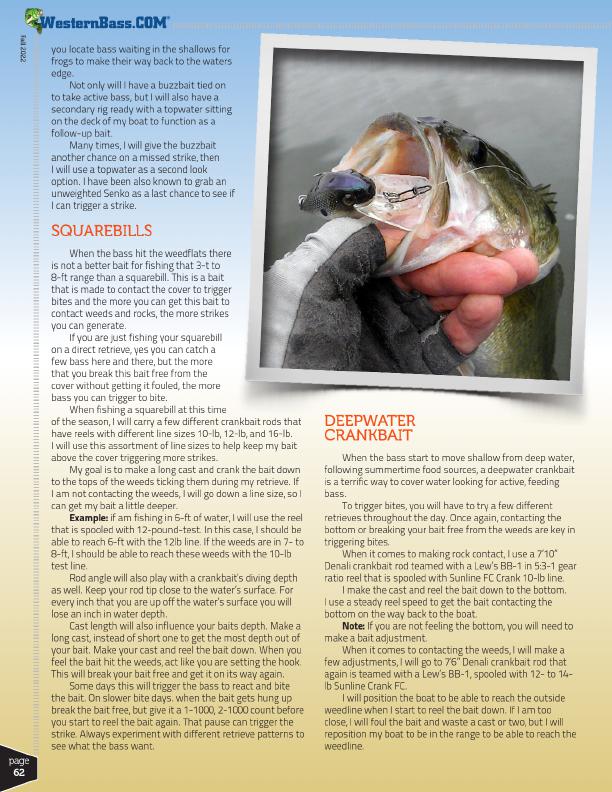
®
Fall 2022
page 62
you locate bass waiting in the shallows for frogs to make their way back to the waters edge.
Not only will I have a buzzbait tied on to take active bass, but I will also have a secondary rig ready with a topwater sitting on the deck of my boat to function as a follow-up bait.
Many times, I will give the buzzbait another chance on a missed strike, then I will use a topwater as a second look option. I have been also known to grab an unweighted Senko as a last chance to see if I can trigger a strike.
SQUAREBILLS
When the bass hit the weedflats there is not a better bait for fishing that 3-t to 8-ft range than a squarebill. This is a bait that is made to contact the cover to trigger bites and the more you can get this bait to contact weeds and rocks, the more strikes you can generate.
If you are just fishing your squarebill on a direct retrieve, yes you can catch a few bass here and there, but the more that you break this bait free from the cover without getting it fouled, the more bass you can trigger to bite.
When fishing a squarebill at this time of the season, I will carry a few different crankbait rods that have reels with different line sizes 10-lb, 12-lb, and 16-lb. I will use this assortment of line sizes to help keep my bait above the cover triggering more strikes.
My goal is to make a long cast and crank the bait down to the tops of the weeds ticking them during my retrieve. If I am not contacting the weeds, I will go down a line size, so I can get my bait a little deeper.
Example: if am fishing in 6-ft of water, I will use the reel that is spooled with 12-pound-test. In this case, I should be able to reach 6-ft with the 12lb line. If the weeds are in 7- to 8-ft, I should be able to reach these weeds with the 10-lb test line.
Rod angle will also play with a crankbait’s diving depth as well. Keep your rod tip close to the water’s surface. For every inch that you are up off the water’s surface you will lose an inch in water depth.
Cast length will also influence your baits depth. Make a long cast, instead of short one to get the most depth out of your bait. Make your cast and reel the bait down. When you feel the bait hit the weeds, act like you are setting the hook. This will break your bait free and get it on its way again.
Some days this will trigger the bass to react and bite the bait. On slower bite days. when the bait gets hung up break the bait free, but give it a 1-1000, 2-1000 count before you start to reel the bait again. That pause can trigger the strike. Always experiment with different retrieve patterns to see what the bass want.
DEEPWATER CRANKBAIT
When the bass start to move shallow from deep water, following summertime food sources, a deepwater crankbait is a terrific way to cover water looking for active, feeding bass.
To trigger bites, you will have to try a few different retrieves throughout the day. Once again, contacting the bottom or breaking your bait free from the weeds are key in triggering bites.
When it comes to making rock contact, I use a 7’10” Denali crankbait rod teamed with a Lew’s BB-1 in 5:3-1 gear ratio reel that is spooled with Sunline FC Crank 10-lb line.
I make the cast and reel the bait down to the bottom. I use a steady reel speed to get the bait contacting the bottom on the way back to the boat.
Note: If you are not feeling the bottom, you will need to make a bait adjustment.
When it comes to contacting the weeds, I will make a few adjustments, I will go to 7’6” Denali crankbait rod that again is teamed with a Lew’s BB-1, spooled with 12- to 14- lb Sunline Crank FC.
I will position the boat to be able to reach the outside weedline when I start to reel the bait down. If I am too close, I will foul the bait and waste a cast or two, but I will reposition my boat to be in the range to be able to reach the weedline.